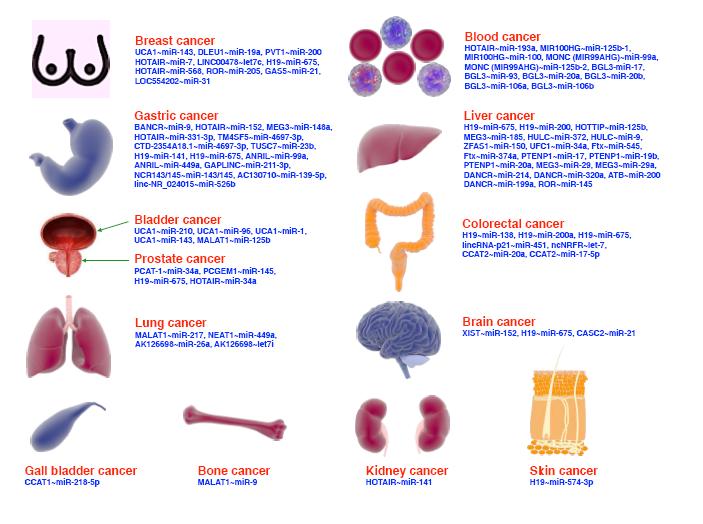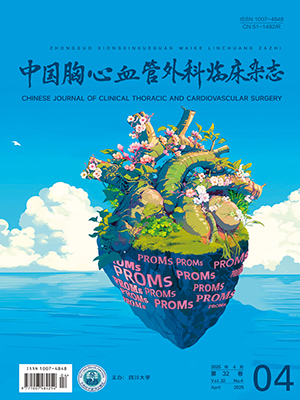Abstract: Objective To investigate the extracellular matrix (ECM) gene expression profile of saphenous vein (SV) in end-stage renal disease (ESRD) patients undergoing coronary artery bypass grafting (CABG). Methods Sixty-eight patients who were diagnosed as coronary artery disease by coronary angiography and admitted to Department of Cardiovascular Surgery,Zhongshan Hospital of Fudan University from July 2004 to December 2010 were enrolled in this study. According to whether or not they had preoperative ESRD history,all the 68 patients were divided into 2 groups,the ESRD group with 30 ESRD patients who needed maintenance hemodialysis,and the control group with 38 patients without preoperative renal disease. Preoperative clinical data of all the patients were collected in detail. SV samples were obtained at the time of CABG. Microarray,immunohistochemistry and Western blotting were used to investigate the expression profile of ECM genes of SV in ESRD patients undergoing CABG. Results There was no statistical difference in preoperative clinical variables between the 2 groups except the variables which were directly related to their kidney disease (P>0.05). There were 16 genes that were up-regulated at least 3-fold and 3 genes that were down-regulated at least 3-fold in the ECM gene expression profile of SV in the ESRD group patients before CABG. The expressions of matrix metalloproteinases-2 (MMP-2) and matrix metalloproteinases-9 (MMP-9) of the ESRD group were significantly higher than those of the control group (2.60±0.50 vs. 0.70±0.16,1.80±0.40 vs. 0.60±0.15,P<0.01). The expressions of tissue inhibitor of metalloproteinase-2 (TIMP-2) and tissue inhibitor of metalloproteinase-3 (TIMP-3) of the ESRD group were significantly lower than those of the control group (0.60±0.19 vs. 2.20±0.30,0.90±0.28 vs. 2.40±0.70,P< 0.05). Conclusion A variety of ESRD-related risk factors of cardiovascular diseases may severely influence on the balance of ECM gene expression of SV before CABG,and the resulting imbalance is a risk factor to aggravate SV graft disease after CABG.
Citation:
SUN Yongxin,DING Wenjun,ZHU Liming,SHI Yunqing,WEI Qiang,WANG Chunsheng .. Characteristics of Extracellular Matrix Gene Expression in Saphenous Vein of Patients with End-stage Renal Disease. Chinese Journal of Clinical Thoracic and Cardiovascular Surgery, 2013, 20(1): 81-86. doi:
Copy
Copyright © the editorial department of Chinese Journal of Clinical Thoracic and Cardiovascular Surgery of West China Medical Publisher. All rights reserved
| 1. |
Foley RN, Parfrey PS, Sarnak MJ. Clinical epidemiology of cardiovascular disease in chronic renal disease. Am J Kidney Dis, 1998, 32 (5):S112-S119.
|
| 2. |
Yerram P, Karuparthi PR, Hesemann L, et al. Chronic kidney disease and cardiovascular risk. J Am Soc Hypertens, 2007, 1 (3):178-184.
|
| 3. |
Goldman S, Zadina K, Moritz T, et al. Long-term patency of saphe nous vein and left internal mammary artery grafts after coronary artery bypass surgery:results from a Department of Veterans Affairs Cooperative Study. J Am Coll Cardiol, 2004, 44 (11):2149-2156.
|
| 4. |
George SJ, Wan S, Hu J, et al. Sustained reduction of vein graft neointima formation by ex vivo TIMP-3 gene therapy. Circulation, 2011, 124 (11 Suppl):S135-S142.
|
| 5. |
Dummler S, Eichhorn S, Tesche C, et al. Pulsatile ex vivo perfusion of human saphenous vein grafts under controlled pressure conditions increases MMP-2 expression. Biomed Eng Online, 2011, 10 (7):62-67.
|
| 6. |
Szczech LA, Reddan DN, Owen WF, et al. Differential survival after coronary revascularization procedures among patients with renal insufficiency. Kidney Int, 2001, 60 (1):292-299.
|
| 7. |
Orii K, Hioki M, Iedokoro Y, et al. Prognostic factors affecting clinical outcomes after coronary artery bypass surgery:analysis of patients with chronic kidney disease after 5.9 years of follow-up. J Nippon Med Sch, 2011, 78 (3):156-165.
|
| 8. |
Koh KH, Tan C, Hii L, et al. Outcome of coronary artery bypass grafting in end stage renal disease patients. Med J Malaysia, 2012, 67 (2):173-176.
|
| 9. |
Turner NA, Ho S, Warburton P, et al. Smooth muscle cells cultured from human saphenous vein exhibit increased proliferation, invasion, and mitogen-activated protein kinase activation in vitro compared with paired internal mammary artery cells. J Vasc Surg, 2007, 45 (5):1022-1028.
|
| 10. |
Mitra AK, Jia G, Gangahar DM, et al. Temporal PTEN inactivation causes proliferation of saphenous vein smooth muscle cells of human CABG conduits. J Cell Mol Med, 2009, 13 (1):177-187.
|
| 11. |
Mangi AA, Dzau VJ. Gene therapy for human bypass grafts. Ann Med, 2001, 33 (3):153-155.
|
| 12. |
NI Jun, Waldman A, Khachigian LM. c-Jun regulates shear- and injury-inducible Egr-1 expression, vein graft stenosis after autologous end-to-side transplantation in rabbits, and intimal hyperplasia in human saphenous veins. J Biol Chem, 2010, 285 (6):4038-4048.
|
| 13. |
Turner NA, Hall KT, Ball SG, et al. Selective gene silencing of either MMP-2 or MMP-9 inhibits invasion of human saphenous vein smooth muscle cells. Atherosclerosis, 2007, 193 (1):36-43.
|
| 14. |
Corpataux JM, Naik J, Porter KE, et al. A comparison of six statins on the development of intimal hyperplasia in a human vein culture model. Eur J Vasc Endovasc Surg, 2005, 29 (2):177-181.
|
| 15. |
Sunagawa G, Komiya T, Tamura N, et al. Coronary artery bypass surgery is superior to percutaneous coronary intervention with drug-eluting stents for patients with chronic renal failure on hemodialysis. Ann Thorac Surg, 2010, 89 (6):1896-1900.
|
| 16. |
Panichi V, Scatena A, Migliori M, et al. Biomarkers of chronic inflammatory state in uremia and cardiovascular disease. Int J Inflam, 2012, 2012:360147.
|
- 1. Foley RN, Parfrey PS, Sarnak MJ. Clinical epidemiology of cardiovascular disease in chronic renal disease. Am J Kidney Dis, 1998, 32 (5):S112-S119.
- 2. Yerram P, Karuparthi PR, Hesemann L, et al. Chronic kidney disease and cardiovascular risk. J Am Soc Hypertens, 2007, 1 (3):178-184.
- 3. Goldman S, Zadina K, Moritz T, et al. Long-term patency of saphe nous vein and left internal mammary artery grafts after coronary artery bypass surgery:results from a Department of Veterans Affairs Cooperative Study. J Am Coll Cardiol, 2004, 44 (11):2149-2156.
- 4. George SJ, Wan S, Hu J, et al. Sustained reduction of vein graft neointima formation by ex vivo TIMP-3 gene therapy. Circulation, 2011, 124 (11 Suppl):S135-S142.
- 5. Dummler S, Eichhorn S, Tesche C, et al. Pulsatile ex vivo perfusion of human saphenous vein grafts under controlled pressure conditions increases MMP-2 expression. Biomed Eng Online, 2011, 10 (7):62-67.
- 6. Szczech LA, Reddan DN, Owen WF, et al. Differential survival after coronary revascularization procedures among patients with renal insufficiency. Kidney Int, 2001, 60 (1):292-299.
- 7. Orii K, Hioki M, Iedokoro Y, et al. Prognostic factors affecting clinical outcomes after coronary artery bypass surgery:analysis of patients with chronic kidney disease after 5.9 years of follow-up. J Nippon Med Sch, 2011, 78 (3):156-165.
- 8. Koh KH, Tan C, Hii L, et al. Outcome of coronary artery bypass grafting in end stage renal disease patients. Med J Malaysia, 2012, 67 (2):173-176.
- 9. Turner NA, Ho S, Warburton P, et al. Smooth muscle cells cultured from human saphenous vein exhibit increased proliferation, invasion, and mitogen-activated protein kinase activation in vitro compared with paired internal mammary artery cells. J Vasc Surg, 2007, 45 (5):1022-1028.
- 10. Mitra AK, Jia G, Gangahar DM, et al. Temporal PTEN inactivation causes proliferation of saphenous vein smooth muscle cells of human CABG conduits. J Cell Mol Med, 2009, 13 (1):177-187.
- 11. Mangi AA, Dzau VJ. Gene therapy for human bypass grafts. Ann Med, 2001, 33 (3):153-155.
- 12. NI Jun, Waldman A, Khachigian LM. c-Jun regulates shear- and injury-inducible Egr-1 expression, vein graft stenosis after autologous end-to-side transplantation in rabbits, and intimal hyperplasia in human saphenous veins. J Biol Chem, 2010, 285 (6):4038-4048.
- 13. Turner NA, Hall KT, Ball SG, et al. Selective gene silencing of either MMP-2 or MMP-9 inhibits invasion of human saphenous vein smooth muscle cells. Atherosclerosis, 2007, 193 (1):36-43.
- 14. Corpataux JM, Naik J, Porter KE, et al. A comparison of six statins on the development of intimal hyperplasia in a human vein culture model. Eur J Vasc Endovasc Surg, 2005, 29 (2):177-181.
- 15. Sunagawa G, Komiya T, Tamura N, et al. Coronary artery bypass surgery is superior to percutaneous coronary intervention with drug-eluting stents for patients with chronic renal failure on hemodialysis. Ann Thorac Surg, 2010, 89 (6):1896-1900.
- 16. Panichi V, Scatena A, Migliori M, et al. Biomarkers of chronic inflammatory state in uremia and cardiovascular disease. Int J Inflam, 2012, 2012:360147.




